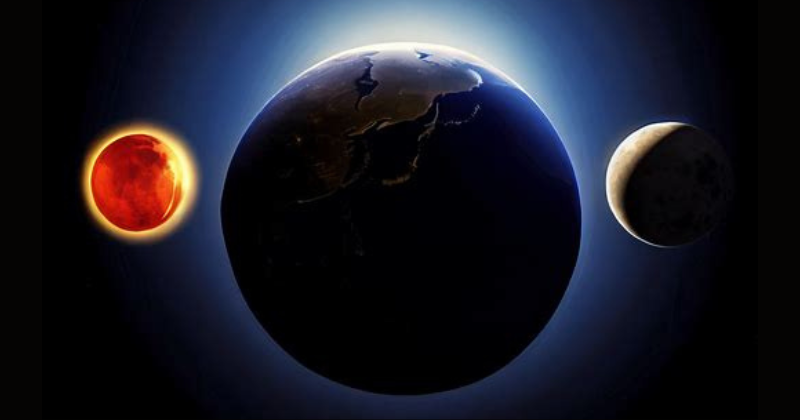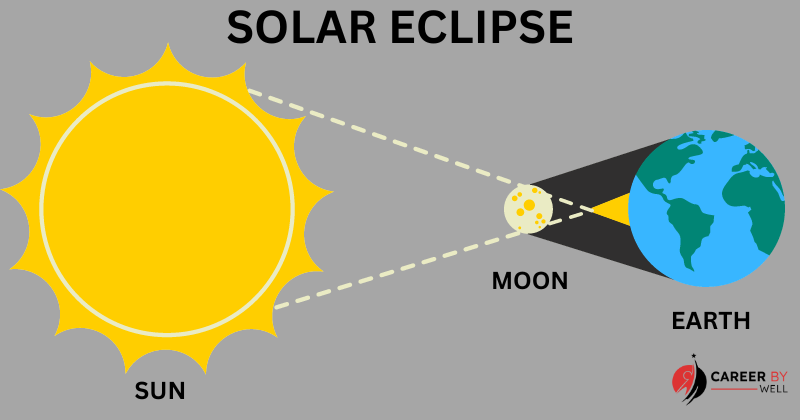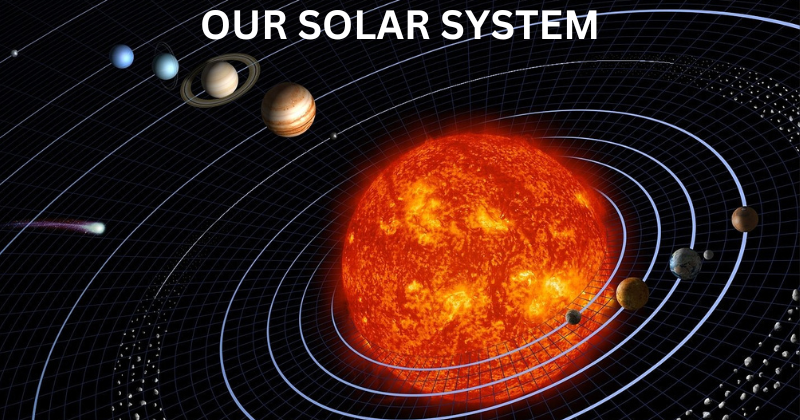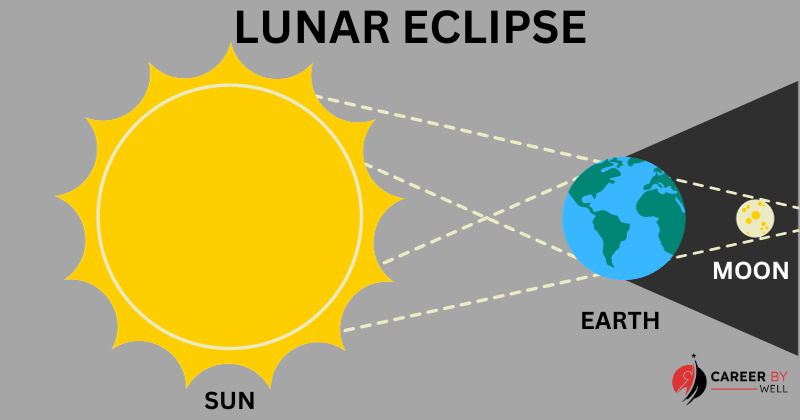Eclipses occur when the Sun, the Moon, or a planet moves into alignment. The most common types are solar and lunar eclipses.
An eclipse is a celestial event that occurs when one celestial object passes in front of or into the shadow of another, temporarily obscuring or blocking its view from an observer’s perspective.
The most common types of eclipses visible from Earth are solar and lunar eclipses.
Generally, Eclipses can be observed on Earth when the Sun, the Moon, or a planet aligns in a way that creates a temporary darkening or obscuration of one of these objects.
Solar Eclipse
A solar eclipse occurs when the Moon passes between the Earth and the Sun, blocking all of the Sun’s light from reaching Earth.
Solar eclipses are captivating and dramatic astronomical events that can be observed from specific regions of the Earth during certain times.
The Moon orbits the Earth in an elliptical path, and this orbit is slightly tilted concerning the plane of the Earth’s orbit around the Sun, known as the ecliptic plane. This tilt is about 5 degrees.
A solar eclipse can only occur during the New Moon phase. The New Moon phase happens when the Moon is positioned between the Earth and the Sun.
During this phase, the side of the Moon facing Earth is not illuminated by the Sun, making it appear completely dark from our perspective.
However, Solar eclipses are not visible from the entire Earth’s surface during a single event. Instead, they are visible within a specific area on Earth where the Moon’s shadow, cast by the Moon blocking the Sun, falls.
This region is known as the “path of totality.”
Besides, Solar eclipses are not visible from the entire Earth’s surface during a single event. Instead, they are visible within a specific area on Earth where the Moon’s shadow, cast by the Moon blocking the Sun, falls.
This region is known as the “path of totality.”
Types of Solar Eclipse
There are three main types of solar eclipses:
- Total Solar Eclipse
- Partial Solar Eclipse
- Annular Solar Eclipse
1. Total Solar Eclipse
In a total solar eclipse, the Moon completely covers the disk of the Sun, resulting in a temporary period of darkness known as totality.
During totality, the sky darkens, and the solar corona, the Sun’s outer atmosphere, becomes visible.
This is a breathtaking sight, with the Sun’s outer atmosphere appearing as a shimmering halo of plasma surrounding the darkened Moon.
Usually, A total solar eclipse occurs when the Moon completely covers the Sun.
The duration of totality, when the Sun is entirely obscured by the Moon, is relatively short, typically lasting only a few minutes at any given location along the eclipse path.
The maximum duration of totality can be around 7 minutes, but most total eclipses have shorter durations.
2. Partial Solar Eclipse
In a partial solar eclipse, the Moon only partially covers the Sun, obscuring a portion of its light.
Observers within the eclipse’s path see the Sun with a chunk missing, resembling a crescent or a bite taken out of the Sun.
Besides, the duration of a partial eclipse depends on how much of the Sun is covered by the Moon. It can last several hours from the beginning of the eclipse until the end.
3. Annular Solar Eclipse
An annular solar eclipse occurs when the Moon is positioned farther from Earth and appears slightly smaller in the sky. As a result, during the eclipse, the Moon does not completely cover the Sun.
Instead, a ring or “ring of fire” is visible around the edges of the Moon, with the Sun appearing as a bright ring or annulus. This type of eclipse is known as an “annular” eclipse.
Generally, the duration of an annular eclipse is typically longer than that of a total eclipse but still relatively short, lasting a few minutes at most along the eclipse path.
Some Scientific Facts About Solar Eclipse
- Solar eclipses are relatively rare events that occur when the Sun, Moon, and Earth align precisely.
- The path of totality for a total solar eclipse, where the eclipse is total, and the solar corona is visible, is usually narrow and can vary with each eclipse.
- Observing a solar eclipse without proper eye protection can cause severe and permanent eye damage. Special solar eclipse viewing glasses or equipment designed for safe solar observation are essential for safely viewing solar eclipses.
- Solar eclipses can have cultural and historical significance and have been observed and documented by civilizations throughout history.
- Solar eclipses provide valuable opportunities for scientific research and public engagement in astronomy.
- They are often the focus of special eclipse-watching events and expeditions, drawing observers and enthusiasts worldwide to witness this remarkable celestial phenomenon.
Lunar Eclipse
A lunar eclipse is a celestial event that occurs when the Earth passes between the Sun and the Moon, causing the Earth’s shadow to be cast onto the Moon.
During a lunar eclipse, the Moon can appear to change colour, often taking on a reddish or copper hue.
A lunar eclipse can only occur during the Full Moon phase. The Earth is positioned directly between the Sun and the Moon during this phase.
The side of the Moon facing Earth is fully illuminated by the Sun, making it appear as a bright, full circle.
As sunlight passes through the Earth’s atmosphere, it is bent or refracted due to the Earth’s atmosphere.
This bending of light causes the Earth’s shadow to have two distinct parts—the penumbra and the umbra.
As the Earth rotates on its axis, the Moon’s position relative to the Earth’s shadow changes, causing the different phases of a lunar eclipse, including the penumbral, partial, and total phases.
Types Of Lunar Eclipse:
There are three main types of lunar eclipses:
- Total Lunar Eclipse
- Partial Lunar Eclipse
- Penumbral Lunar Eclipse
1. Total Lunar Eclipse
In a lunar eclipse, the entire Moon passes through the Earth’s central shadow, the umbra. The Moon can appear reddish or coppery when it is completely within the umbra.
It is due to the scattering of sunlight through the Earth’s atmosphere, which bends longer-wavelength red and orange light around the Earth and onto the Moon. This phenomenon is sometimes referred to as a “blood moon.”
Generally, a total lunar eclipse can vary but typically lasts a few hours. It includes the time it takes for the Moon to move through the Earth’s umbral shadow (total phase), which can last up to about 1 to 1.5 hours, along with the partial phases before and after totality.
Further, The entire eclipse may last several hours, from the beginning of the penumbral phase to the end of the penumbral phase.
2. Partial Lunar Eclipse
In a partial lunar eclipse, only a portion of the Moon passes through the Earth’s umbra, while the rest remains outside the shadow.
During a partial lunar eclipse, a section of the Moon gradually darkens and then re-emerges into full brightness as it moves through the Earth’s shadow.
Additionally, The duration of a partial lunar eclipse can also vary but generally lasts for several hours.
3.Penumbral Lunar Eclipse:
Penumbral lunar eclipses are distinct from the other types because they involve the Moon passing through the Earth’s penumbral shadow, which is the outer, lighter part of its shadow.
Penumbral lunar eclipses are less dramatic and visually striking than total lunar eclipses, where the Moon can turn a reddish or copper colour, or partial lunar eclipses, which show a significant portion of the Moon obscured by Earth’s shadow.
In contrast, penumbral eclipses may go unnoticed by casual observers.
A penumbral lunar eclipse occurs when the Moon passes through the Earth’s penumbral shadow, a more diffuse and lighter shadow.
These eclipses can be subtle, and the darkening of the Moon is less noticeable. The duration of a penumbral lunar eclipse can be several hours.
Some Scientific Facts About Lunar Eclipse
- Unlike solar eclipses, lunar eclipses are safe to observe with the naked eye, and no special eye protection is required.
- Lunar eclipses can last for several hours, with the total phase (when the Moon is entirely within the Earth’s umbra) typically lasting about an hour.
- The frequency of lunar eclipses is higher than that of solar eclipses. Lunar eclipses can occur twice a year, 2-4 times. They are visible from any location on the night side of the Earth.
- The appearance of a lunar eclipse can vary depending on the Earth’s atmospheric conditions. Dust and particles in the Earth’s atmosphere can affect the colour and brightness of the eclipsed Moon.
Things to know about Solar and Lunar Eclipse
Generally, Eclipses are awe-inspiring phenomena that provide scientific insights and moments of wonder for people worldwide.
- Eclipses occur in predictable cycles called Saros cycles. These cycles repeat approximately every 18 years and 11 days. This means you can expect a similar eclipse to occur in a specific region after this period.
- While solar and lunar eclipses are not exceedingly rare, they are not visible from the same location very frequently. For example, the path of totality for a solar eclipse can cross a specific region on Earth once every few centuries.
- During a lunar eclipse, the Moon enters the penumbra before moving into the umbra. The Earth’s shadow has two parts
- the penumbra, which is the outer, lighter part, and
- the umbra, which is the inner, darker part.
- Usually, a solar eclipse always occurs two weeks before or after a lunar eclipse.
- Solar eclipse happened on new moon day while lunar eclipse happened on full moon day.
- On average, there are about 2 to 5 solar eclipses and 2 to 4 lunar eclipses each year. Although not all of them are visible from a specific location.
- The duration of a total solar eclipse can vary. However, it typically lasts for just a few minutes at any given location along the eclipse path.
- Generally, lunar eclipses are more extended in duration compared to solar eclipses.
- An eclipse can happen with another planet in the solar system when that planet, its moon and sun align.
The occurrence of eclipses is predictable and can be calculated using astronomical models. Eclipses are often part of a repeating cycle known as the Saros cycle. This occurs approximately every 18 years and 11 days. During a Saros cycle, eclipses with similar characteristics and paths repeat.



